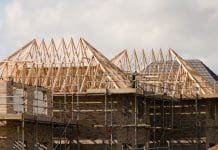Dave Lancaster, Senior Commercial Manager at Uponor, discusses how offsite construction and the systems used in modular assemblies have advanced in recent years and why housebuilders must adopt MMC to meet the demands of the housing crisis
Historically, some of the biggest housebuilders have been sceptical about modular building. However, with last year’s shortages impacting both materials and labour, the arguments in favour of offsite housing production have come to the forefront: fully fitted kitchen and bathroom pods can be delivered and bolted together onsite in a matter of days; factory-assembly provides greater quality control and less reliance on bands of subcontractors; wastage is minimised; and less time building homes should improve the key metric of return on capital employed.
Plus, with the number of new homes being built still requiring an increase of 24% to reach 300,000 homes per annum and meet government targets, more widespread adoption of modern methods of construction (MMC) is becoming the norm, as these numbers would be an extremely tall order using traditional methods of construction alone.
Building momentum
The latest statistics1 show that nearly 50,000 new homes were built in the first three months of 2021, the highest figure in over 20 years. But since then, the construction industry has been hit by a variety of challenges that have caused projects to suffer from delays and unanticipated costs. As a result, methods such as offsite manufacturing are gaining popularity due to its positive impact on productivity, and the speed to which homes, hospitals and schools are being constructed.
In 2021, Savills predicted that the proportion of new housing developments built using MMC would need to increase from the current 6-10% to 20% of the market in the coming years in order to meet the Government’s target of building 300,000 homes each year by 2025.
The construction industry has grappled with shortages of skilled workers for years as a result of ageing workforces, but the double shocks of Brexit and Covid have exacerbated these problems. In fact, in September 2021, The Office for National Statistics found that 43,000 jobs were unfilled across construction – the highest volume of vacancies in the sector for over two decades.
In light of these pressures, offsite housing construction has the potential to achieve faster delivery on-site than traditional construction – with schemes completed in about two-thirds of the time, helping to avoid costly delays due to the lack of onsite labour available.
In addition to enhanced productivity, offsite construction is also proving to be a much more cost-effective method of building. In fact, the Buildoffsite report estimates that the cost of remedying construction defects onsite adds around 2% to an onsite project’s overall cost, while onsite waste amounts to 3-5% of overall costs.
In contrast, the costs for offsite manufacturing are close to 0% for remedying defects, and 1-3% for waste costs, demonstrating that offsite construction could actually help housebuilders to make substantial savings.
Furthermore, as well as helping to address the urgent demand for housing, modular construction could also play a major role in reducing the industry’s carbon footprint as it is a greener way to meet the demand for new homes. Factory-controlled environments allow production methods to be streamlined, resulting in less waste and higher efficiencies. Any waste that is produced can also be better controlled and recycled, with less risk of contaminating other materials. Energy use can also be regulated more easily in a factory setting, and, as fewer lorries – and people – are required to deliver fully fitted modules to site, carbon emissions are reduced significantly.
Turning up the heat
Modular construction has come a long way in recent years. Advances in technology now means that modern pipes such as MLC are the perfect choice for factory-based construction of modular units that require domestic services and all types of energy efficient heating systems. By using modern plumbing schemes such as manifold plumbing, fewer fittings are required which minimises the potential risk of leakage, and also helps to provide faster hot water delivery which in turn saves energy and reducing the home’s operational carbon emissions long-term.
Installation quality is now extremely high in systems installed offsite as those who carry out the work specialise in a specific area, such as plumbing. At Uponor, we work closely with our modular construction partners and provide continuous training and on-going installation quality reviews to ensure consistency in the use of our products and installation, which leads to greater precision and quality control.
Fitting high performance pre-insulated pipework, with special insulation to provide increased fire safety, into modular assemblies in a controlled factory environment also helps to increase efficiencies and minimise any potential heat loss. Prior to the delivery of the module to the construction site, testing of the system using air maintains the hygiene of the domestic services whist providing necessary reassurance of the integrity for the installed system.
Underfloor heating (UFH) is an ideal solution when it comes to providing enhanced thermal comfort for homes. Radiant systems can be installed under the floor, behind a wall or above a ceiling which makes them perfect for modular assemblies in which space can be limited. In recent years, low profile heating systems such as Uponor’s Minitec have also come to the forefront, which allows even more design freedom in space-limited modules.
Futureproofing our homes
Many climate change studies suggest that indoor temperatures will rise above the comfort threshold of 26°C in the near future. This means that the energy needed for cooling will exceed the energy required for heating. To overcome this, future-oriented temperature control in homes must include both heating and cooling while also being as energy-efficient as possible.
Radiant emitter systems can be used to either heat or cool an area at a consistent temperature and can be easily controlled in individual rooms, or pods, via a dedicated thermostat which provides the best thermal profile for a specific area of a modular build. This is a more efficient way to heat a home, as energy isn’t wasted in rooms that are not in use, and is estimated to be between 20-25% more energy efficient than convectional heating.
Underfloor heating systems are also easier to use for cooling. Hydronic cooling systems pass water through the pipes which absorb the heat within a room cooling the environment and preventing overheating. The system’s temperature controls prevent the build-up of heat during warmer periods by reducing the degree to which building mass heats up. The result is that surfaces are kept cooler and the internal ambient air temperature remains more comfortable.
Tackling operational emissions
Under Part L1A of the Building Regulations building a new home in the UK will come with extra energy-efficiency requirements. The changes to Part L state that there will be a maximum flow temperature requirement of 55°C for new and replacement heating systems, meaning that more renewable heating systems must be used in today’s modular builds.
Underfloor heating systems have a larger area heat emitter than traditional radiators, meaning that they require a lower heat input in order to heat a room effectively. This allows the system to work efficiently in conjunction with renewable and low-energy heating technologies such as air source heat pumps (ASHP), which help to reduce a home’s operational carbon footprint and energy bills.
For many years, housebuilders have been put off by the size and aesthetic appearance of heat pumps. However, with technology advancing constantly, plus grants available from April 2022, heat pumps are now becoming more mainstream, making the combination of ASHP and UFH an ideal match for modular assemblies. We are increasingly advising clients in this area and anticipate a large uplift from April onwards.
The future lies in modular construction
As modular building becomes increasingly advanced, it is clear that offsite construction now offers enhanced productivity, quality control, and return on investment which will help us to create an integrated way of working that has the potential to transform the sector. The chronic need for new homes combined with the growing pressure on the sector to cut carbon emissions and tackle sector-wide shortages, means that modular construction must now be seriously considered by housebuilders, both large and small.
If we truly wish to revolutionise the industry, meet targets and create the high-quality, technologically-advanced, energy efficient homes of the future, it could be time to leave the dangerous, wasteful building sites behind and consider the fact that housebuilding’s future may well be in the factory.
References
1 Government home building statistics: https://www.gov.uk/government/news/home-building-stats-show-continued-increase-in-starts-and-completions-despite-pandemic
2 Better understanding of the housing market: https://www.placesforpeople.co.uk/media/2tapxt1f/better-understanding-the-housing-market-october-2021.pdf


![Modular_Building_Small[2] modular assemblies](https://www.pbctoday.co.uk/news/wp-content/uploads/2022/01/Modular_Building_Small2-1068x763.jpg)












A good article. Modular is very good for certain applications, although may not be the most efficient for private developers, where they need to react to market demand. The reality is that Modular (although depends on the definition) is probably best for social housing / Govt backed schemes where the factory / large volume nature required for factory production can be taken advantage of. For many schemes at the moment, modular can work out more expensive and requires funding much earlier than traditional, but its complex and not black and white. There are still a number of things within the Modular industry that need to be worked out, its getting there though, which is good. Scalability will be the next natural issue to tackle if the modular industry can truly deliver, but for that it will need a critical massive to allow for investment. The Government and Industry though, must NOT forget that, just because people will be working in a factory it still requires massive investment in the trades and technical skills.